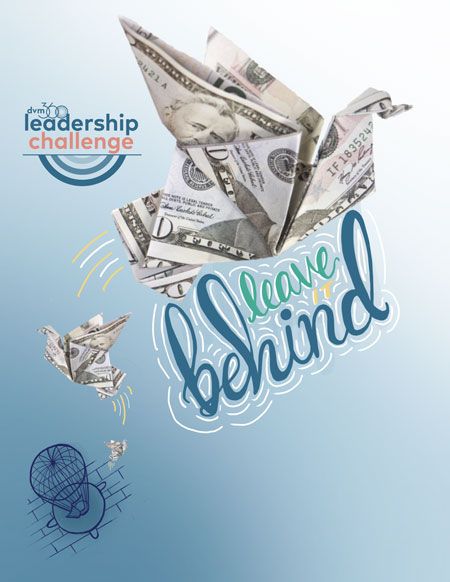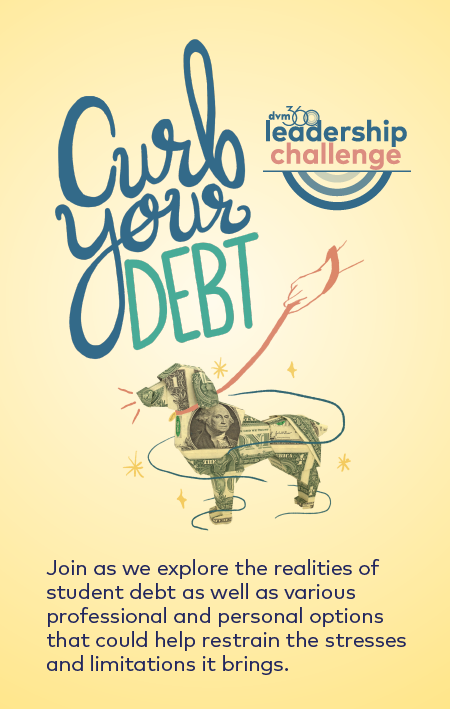Finding freedom: The smart way to leave your student debt behind
It keeps you awake at night. It overshadows every life decision. It may even make you question your career choice. But you can be free of the soul-sucking burden of your veterinary student debtas long as you have the right information and the right plan.

Photo illustration: Adobe Stock, Roxy TownsendWith the current United States student loan debt reaching $1.5 trillion and affecting more than 44 million Americans, it's not surprising that this debt has become a hot topic. Many veterinarians face student loans well into the six figures, and with starting salaries averaging $75,000 to $100,000, veterinarians have been some of the hardest hit by this issue.
As I speak with recent vet grads, I've found it's not uncommon for them to say they're not sure they would have become veterinarians if they'd known how stressful the student debt would be. This pains me to hear, although I can't say I'm shocked. As a financial professional, my goal is to provide the necessary education and assistance to reduce the anxiety associated with these student loans.
Compared with other financial professionals, I have a bit of a unique perspective on this subject. I'm experiencing it all firsthand because my wife is a veterinarian. Upon graduation, my wife was fortunate enough to already have a job lined up. She began working and, when the time came, started paying on her loans. At that time the focus was on her career and there was plenty of stress involved with being a new doctor in the veterinary profession.

The loans were being paid, but I can't say we necessarily had a plan. There just wasn't enough emotional bandwidth for her to deal with the new career and this seemingly impossible amount of debt. Once we were married, I decided it was time to dig into this situation and figure out what plan was best for our financial future.
As I began to research, I found that a ton of information was available, but much of it was contradictory. I understand how all this information can quickly become confusing. And unfortunately, the easiest thing to do as a result is ignore the problem. The goal of this article is to provide you with the necessary education so that you'll feel confident enough to take the first step in tackling your student debt.
During a student loan consultation, I always start the meeting with two points. First, congratulations on becoming a veterinarian! Thousands of people dream of doing what you've done and never reach that goal, so you should be extremely proud. Although these loans seem terrible, they did help make it possible for you to achieve your dream.
Second, you're not alone. As I mentioned previously, there are more than 44 million Americans with student loans and many of them are in a similar situation as you. Your well-being is important, and if you feel overwhelmed, you shouldn't hesitate to ask for help.
Keeping that in mind, let's dive in. My goals here are to help you:
- Educate yourself.
- Define the methods.
- Narrow your options.
- Tackle your debt.
Understanding your loans: the basics
Before you create a plan, it's important to understand the details of your loans. The first distinction is to determine if you have federal loans or private loans. This information can be located on your statement from the loan servicer-keep in mind it's not uncommon to have a mix of federal and private loans. The next step is to ascertain which loans are subsidized and which are unsubsidized. A subsidized loan does not begin collecting interest until the end of your six-month grace period. Unsubsidized loans begin accruing interest the day they're taken out, even if you're still in school.
It's also important to identify the interest rate on each loan. This rate will determine how much of each payment goes to paying down the loan. Finally, it's critical for you to understand the total unpaid balance on all of your loans. Becoming familiar with these items will make it easier to understand the options available and decide what strategy best fits your scenario.
Before going into all of the repayment and forgiveness options, I want to share one of the most common mistakes I see being made. This mistake is refinancing federal loans into a private loan without fully understanding all of the options that are being given up with this choice. I'm not saying private loan refinance is always a bad option, but it's crucial to realize that once a federal loan is refinanced into a private loan, it cannot go back.
Federal loan repayment options
Now, let's dive into the different repayment options available for federal loans.
Standard repayment. This is the default plan for federal loans. It has a 10-year amortization, meaning you'll make equal payments for 10 years and your loan will be paid off at the end of that 10-year period.
Graduated repayment. This plan also has a 10-year payoff, but the payments are smaller at the beginning and increase every two years.
Extended repayment. As the name implies, this plan extends the repayment period out to 25 years. This means the monthly payments will be smaller, but you'll be paying for a longer time, which means paying more in interest.
It's important to note that the three plans above do not factor in your income; the monthly payment amounts are based purely on math and will not fluctuate with changes in your earnings. And while it's helpful to be aware of these plans, for many veterinarians with six-figure debt, none of them is going to be the most effective strategy.
Next are the plans that do take income into account. Naturally, these plans fit into the category known as income-driven repayment (IDR) plans. These plans ensure that monthly student loan payments do not exceed a certain percentage of your income. This can be quite beneficial for individuals with higher student loan debt than their annual salary, which is the case for many new veterinarians.
Income-Based repayment. The oldest and most well-known plan in the IDR category is Income-Based Repayment (IBR). Under this plan, payments are equal to 15 percent of discretionary income and any remaining loan balance is forgiven after 25 years on loans taken out before July 2014. For loans that originated after July 2014, the payments are equal to 10 percent of discretionary income and balances are forgiven after 20 years.
Pay As You Earn. The second IDR plan that was created is known as Pay As You Earn (PAYE). This plan is available to new borrowers after October 2007 and offers payments at 10 percent of discretionary spending and balance forgiveness after 20 years. A frequent question I hear is, if I have some loans from before and some loans after October 2007, can I use this plan for the loans after that date? The answer is that, unfortunately, if you have any student loans taken in your name before October 2007, you do not qualify for this plan.
Revised Pay As You Earn. In 2015, the Department of Education released a new plan that offers favorable treatment to a larger group of borrowers. The new plan they created is called Revised Pay As You Earn (REPAYE). Under this plan, monthly payments are equal to 10 percent of discretionary income, undergraduate loan balances are forgiven after 20 years, and graduate balances are forgiven after 25 years.
So, I've discussed multiple payment options for government loans, but what if you're unable to make any payment at this time? Fortunately, federal loans have some included options for delaying payments due to financial hardship. The first option, known as deferment, is intended for short-term issues. The typical deferment period is 60 days. This allows the borrower to avoid the monthly payment without any late fees or negative credit impacts. The other delay option is called forbearance, and it's intended for longer-term situations. The forbearance period can be up to 12 months and the borrower will not incur any late fees during this time. The loans will, however, continue to accrue interest.
Plan
Payment
Forgiveness
Standard repayment Fixed payment for 10-year payoff N/A Graduated repayment Payments are lower at first and then increase, usually every two years, and are for an amount that will ensure your loans are paid off within 10 years. N/A Extended repayment Payments may be fixed or graduated and will ensure that your loans are paid off within 25 years. N/A Income-Based Repayment (IBR) Payments equal to 15% of discretionary income (loans before July 2014). Payments equal to 10% of discretionary income (loans after July 2014). 25 years (loans before July 2014); 20 years (loans after July 2014) Pay As You Earn (PAYE) Payments equal to 10% of discretionary income (new borrowers after October 2007). 20 years Revised Pay As You Earn (REPAYE) Payments equal to 10% of discretionary income. 20 years (undergraduate loans); 25 years (graduate loans)
Private loans
Private student loans are much more straightforward than federal loans. These loans operate very much like a typical home or auto loan. Payments on a private loan will stay the same throughout the term of the loan unless the interest rate is variable. The vast majority of private student loans do not offer income-driven repayment plans, deferment or forbearance.
Strategies for repayment
Hopefully, now you have a little bit better understanding of the student loans you have and some of the available options. With that knowledge, let's move forward by discussing the strategies for tackling these loans. For student loan debt, there are essentially two opposing strategies. One is to pay the loan off as quickly as possible. The other is to pay as little as possible. The most challenging detail is evaluating which strategy best suites your position and then implementing that strategy at the highest efficiency. Let's discuss the pros and cons of each strategy.
1. Get rid of it fast. The first strategy is to pay off the loans as quickly as possible, which seems fairly easy to understand. The goal here is to pour every dollar you can afford into your loans and free yourself of that student loan debt as soon as you humanly can. But before choosing this strategy, ask yourself if you can commit to the sacrifice. For many veterinarians, the monthly payments can be thousands of dollars. The result is that many large expenses will need to be delayed. You may need to wait longer before buying a house, reduce vacations and travel, and likely drive an older car. It's important to consider how this strategy will affect your well-being. If you're comfortable committing to this lifestyle for the next 10 years, this strategy might be best for you.
Don't let your psyche trick you
Being the upstanding, hardworking people most veterinarians are-and given that student debt is such a drain on the profession right now-many folks assume that the best way to deal with their veterinary debt is to get rid of it ASAP. Plus, popular personal finance personalities are out there evangelizing for a debt-free lifestyle, so it seems obvious that you'd want to jettison that toxic load in as few years as possible, even if it means living at poverty level or delaying important life events like buying a house and having kids.
Not so fast. You need to fight your psychological abhorrence for your debt load with a calm, rational approach. In other words, stop screaming, “Get it off! Get it off!” and run the numbers. It may very well be that under an income-driven plan paying just a little bit per month, you'll come out ahead-i.e. pay less overall-when the balance is forgiven, even after you've paid the tax bill at that time. The smarter thing to do may be to make loan payments you can manage, live your life and start saving for the taxes on the forgiveness.
Consult a knowledgeable advisor or use the VIN Foundation's Student Loan Repayment Simulator (available at vinfoundation.org) to see what's best for your financial future.
-dvm360 staff
2. Let it linger-and get forgiven. The second strategy is to pay as little as possible and work toward loan forgiveness. If your student loan debt is not more than your annual salary, I would not likely recommend this strategy for you. If your debt is not greater than your salary, mathematically this plan is not as effective. You would not be able to substantially lower your payment and would often pay off the loan before reaching the forgiveness period. If you fall into this bucket, I would encourage you to consider the first strategy and avoid the additional interest of a longer payoff period. The way the second strategy works is to utilize the best income-drive repayment plan for you to get the monthly payment as low as possible and continue to make these payments until your loans are forgiven.
The most well-known forgiveness plan is the Public Service Loan Forgiveness (PSLF) plan. This is a great option if you qualify; unfortunately, not very many veterinary jobs do. The criteria include working for a government or nonprofit organization, working a minimum of 30 hours a week, and working in that position for 10 years while making timely student loan payments. If you meet all of these requirements, your remaining loan balance will be forgiven and there is no tax liability.
I find it interesting that most people are familiar with the PSLF program but do not realize that everyone using an income-driven repayment plan is eligible for forgiveness. Depending on your specific situation, your remaining student loan balance can be forgiven after 20 or 25 years of making payments under an IDR plan. The natural objection to this idea is that borrowers don't want to be paying for 20 or 25 years on their student loans. But in reality, for individuals with high student loans, it's often not financially plausible to pay off the loans much more quickly than that anyway.
If you use an IDR plan and work toward loan forgiveness, the total amount you pay over 20 or 25 years can actually be significantly less than if you'd used a standard repayment plan or paid the balance off as soon as possible. However, keep in mind that loan balances forgiven under an IDR plan are treated as income and taxed accordingly. I always encourage individuals to work with a financial advisor to help them plan for this potential tax burden.
Parting thoughts
In conclusion I'd like to share a few additional pieces of advice. I highly recommend that you include your significant other in this process and the decision making. Second, don't be afraid to enlist the help of an expert. This can be a very confusing situation and you don't need to feel ashamed asking for help. Finally, always remember that there are many others in your position and you are not alone. As bad as it may seem, there are always options.
Stephen Brinker, MBA, is a financial pro

fessional with Kalibr, a financial planning firm based in St. Louis. The spouse of a veterinarian, he understands the financial challenges many veterinary professionals face. Brinker graduated from the University of Missouri-St. Louis with a master's in business administration with emphasis in accounting. Contact dvmnews@ubm.com with questions or comments.
